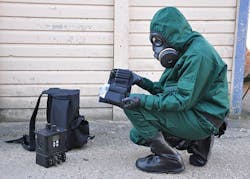Air Force chooses fourth company for active infrared spectroscopy chemical-detection
Officials of the U.S. Air Force Research Laboratory at Wright-Patterson Air Force Base, Ohio, announced an $11.2 million contract Tuesday to the LGS Innovations LLC Applied Research and Technology segment in Florham Park, N.J., for the Standoff Illuminator for Measuring Absorbance and Reflectance Infrared Light Signatures (SILMARILS) project.
LGS Innovations joins Spectrum Photonics Inc. in Honolulu, Hawaii; Block Engineering Inc. in Marlborough, Mass.; and Leidos Inc. in Reston, Va., on the SILMARILS program. Spectrum Photonics won a $16.9 million contract on 16 Feb., Block Engineering won a $9.4 million contract on 12 Feb., and Leidos received a $17.9 million contract to develop the system on 2 Feb. 2016.
The Air Force Research Lab is awarding the contracts to the four companies on behalf of the U.S. Intelligence Advanced Research Projects Agency (IARPA) in Washington. IARPA is the research arm of the Office of the Director of National Intelligence.
Related: Army orders pocket-size, rugged, handheld chemical warfare detectors from Smiths Detection
The contracts call for the companies to develop a portable system for real-time standoff detection and identification of trace chemical residues on surfaces using active infrared spectroscopy at a 30-meter range.
LGS Innovations specializes in wireless communications, RF spectrum analysis, cyber security, fiber optic and free-space optical communications, and mobile broadband technologies for communications, sensing, and analytical applications.
Standoff chemical-detection is a ubiquitous need across the intelligence community for applications ranging from forensic crime scene analysis to border and facility protection to stockpile and production monitoring, IARPA officials say.
Current systems, however, do not provide the sensitivity, specificity, and low false-alarm rates necessary to detect trace chemicals of interest in a cluttered, real-world environment.
Related: Industry asked for technologies to detect and counter chemical and biological weapons
Goals of the SILMARILS program include high chemical sensitivity and specificity across a broad range of target classes; effective operation amid gas phase and surface-adsorbed clutter, varying substrates, temperature, humidity, and indoor and outdoor background light; an eye-safe system with a visually unobservable illumination beam; portable size and power draw for limited-duration battery operation; and a rapid scan rate.
The key overarching objective of the SILMARILS program is not just to develop a spectrometer that can produce high-resolution infrared spectra in the laboratory, but also to develop a system that can identify target chemicals in the field with real-world clutter and background.
The four companies are developing physical spectrometer hardware and detection and discrimination algorithms that detect nitro-based compounds such as TNT and RDX, acetone peroxide, and home-made explosives such as fertilizer bombs; chemical weapons such as sarin or tabun, as well as toxic chemicals that may be intentionally or unintentionally released such as hydrogen cyanide or ammonia gas; and illicit drugs such as cocaine, heroin, or methamphetamine, or legal but abused drugs such as Vicodin or hydrocodone.
IARPA officials also would like the instrument to detect compounds associated with the manufacture and deployment of biological agents and nuclear materials.
Related: Canadian military chooses iRobot UGVs to detect chemical agents, explosives, and radiation
The companies will investigate coupling broadband coherent sources with interferometric spectroscopy in wavebands like long wave infrared (LWIR), mid-wave infrared (MWIR), and short-wave infrared (SWIR).
The job involves creating tailored algorithms and specific background and clutter filter approaches; understanding how surface and particle effects influence spectral signatures; designing an optical train from existing and purpose-developed component technology; and developing a prototype for field testing.
On this contract LGS Innovations will do the work in Florham Park, N.J., and should be finished by October 2020.
For more information contact LGS Innovations online at www.lgsinnovations.com; Spectrum Photonics at http://spectrum-photonics.com, Block Engineering at www.blockeng.com, Leidos at www.leidos.com, IARPA at www.iarpa.gov, or the Air Force Research Laboratory at www.wpafb.af.mil/AFRL.
